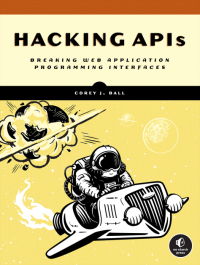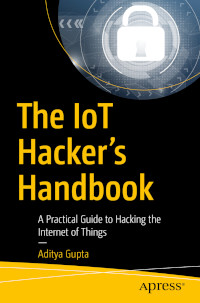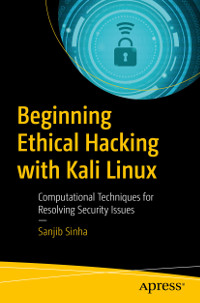Hacking eBooks
Hacking APIs
An Application Programming Interface (API) is a software connection that allows applications to communicate and share services. Hacking APIs will teach you how to test web APIs for security vulnerabilities. You'll learn how the common API types, REST, SOAP, and GraphQL, work in the wild. Then you'll set up a streamlined API testing lab and perform common attacks, like those targeting an API's authentication mechanisms, and the injection vulnerabilities commonly found in web applications. In the book's guided labs, which target intentionally vulnerable APIs. By the end of the book, you'll be prepared to uncover those high-payout API bugs that other hackers aren't finding, and improve the security of applications on the web. ...
An Application Programming Interface (API) is a software connection that allows applications to communicate and share services. Hacking APIs will teach you how to test web APIs for security vulnerabilities. You'll learn how the common API types, REST, SOAP, and GraphQL, work in the wild. Then you'll set up a streamlined API testing lab and perform common attacks, like those targeting an API's authentication mechanisms, and the injection vulnerabilities commonly found in web applications. In the book's guided labs, which target intentionally vulnerable APIs. By the end of the book, you'll be prepared to uncover those high-payout API bugs that other hackers aren't finding, and improve the security of applications on the web. ...
Mastering Kali Linux for Advanced Penetration Testing, 4th Edition
Remote working has given hackers plenty of opportunities as more confidential information is shared over the internet than ever before. In this new edition of Mastering Kali Linux for Advanced Penetration Testing, you'll learn an offensive approach to enhance your penetration testing skills by testing the sophisticated tactics employed by real hackers. You'll go through laboratory integration to cloud services so that you learn another dimension of exploitation that is typically forgotten during a penetration test. You'll explore different ways of installing and running Kali Linux in a VM and containerized environment and deploying vulnerable cloud services on AWS using containers, exploiting misconfigured S3 buckets to gain access to EC2 instances. This book delves into passive and active reconnaissance, from obtaining user information to large-scale port scanning. Building on this, different vulnerability assessments are explored, including threat modeling. See how hackers use lat ...
Remote working has given hackers plenty of opportunities as more confidential information is shared over the internet than ever before. In this new edition of Mastering Kali Linux for Advanced Penetration Testing, you'll learn an offensive approach to enhance your penetration testing skills by testing the sophisticated tactics employed by real hackers. You'll go through laboratory integration to cloud services so that you learn another dimension of exploitation that is typically forgotten during a penetration test. You'll explore different ways of installing and running Kali Linux in a VM and containerized environment and deploying vulnerable cloud services on AWS using containers, exploiting misconfigured S3 buckets to gain access to EC2 instances. This book delves into passive and active reconnaissance, from obtaining user information to large-scale port scanning. Building on this, different vulnerability assessments are explored, including threat modeling. See how hackers use lat ...
Game Hacking Academy
Hacking games requires a unique combination of reversing, memory management, networking, and security skills. Even as ethical hacking has exploded in popularity, game hacking still occupies a very small niche in the wider security community. While it may not have the same headline appeal as a Chrome 0day or a massive data leak, the unique feeling of creating a working aimbot for a game and then destroying a server with it is hard to replicate in any other medium. When I first started learning game hacking years ago, resources were spread out across several sites and were very sparse. Typically, you would find a section of code that linked to a broken site. You would then search around for some forum that would have some part of the broken site in a post and piece together the information. While this rewarded thorough searching, it was a massive time-sink. These days, there are several places where you can find a variety of information regarding game hacki ...
Hacking games requires a unique combination of reversing, memory management, networking, and security skills. Even as ethical hacking has exploded in popularity, game hacking still occupies a very small niche in the wider security community. While it may not have the same headline appeal as a Chrome 0day or a massive data leak, the unique feeling of creating a working aimbot for a game and then destroying a server with it is hard to replicate in any other medium. When I first started learning game hacking years ago, resources were spread out across several sites and were very sparse. Typically, you would find a section of code that linked to a broken site. You would then search around for some forum that would have some part of the broken site in a post and piece together the information. While this rewarded thorough searching, it was a massive time-sink. These days, there are several places where you can find a variety of information regarding game hacki ...
The Hardware Hacking Handbook
Embedded devices are chip-size microcomputers small enough to be included in the structure of the object they control, and they're everywhere - in phones, cars, credit cards, laptops, medical equipment, even critical infrastructure. This means understanding their security is critical. The Hardware Hacking Handbook takes you deep inside different types of embedded systems, revealing the designs, components, security limits, and reverse-engineering challenges you need to know for executing effective hardware attacks. Written with wit and infused with hands-on lab experiments, this handbook puts you in the role of an attacker interested in breaking security to do good. Starting with a crash course on the architecture of embedded devices, threat modeling, and attack trees, you'll go on to explore hardware interfaces, ports and communication protocols, electrical signaling, tips for analyzing firmware images, and more. Along the way, you'll use a home testing lab to perform fault- ...
Embedded devices are chip-size microcomputers small enough to be included in the structure of the object they control, and they're everywhere - in phones, cars, credit cards, laptops, medical equipment, even critical infrastructure. This means understanding their security is critical. The Hardware Hacking Handbook takes you deep inside different types of embedded systems, revealing the designs, components, security limits, and reverse-engineering challenges you need to know for executing effective hardware attacks. Written with wit and infused with hands-on lab experiments, this handbook puts you in the role of an attacker interested in breaking security to do good. Starting with a crash course on the architecture of embedded devices, threat modeling, and attack trees, you'll go on to explore hardware interfaces, ports and communication protocols, electrical signaling, tips for analyzing firmware images, and more. Along the way, you'll use a home testing lab to perform fault- ...
Ethical Hacking
Ethical Hacking is a crash course in modern hacking techniques. It's already being used to prepare the next generation of offensive security experts. In its many hands-on labs, you'll explore crucial skills for any aspiring penetration tester, security researcher, or malware analyst. You'll begin with the basics: capturing a victim's network traffic with an ARP spoofing attack and then viewing it in Wireshark. From there, you'll deploy reverse shells that let you remotely run commands on a victim's computer, encrypt files by writing your own ransomware in Python, and fake emails like the ones used in phishing attacks. In advanced chapters, you'll learn how to fuzz for new vulnerabilities, craft trojans and rootkits, exploit websites with SQL injection, and escalate your privileges to extract credentials, which you'll use to traverse a private network. You'll work with a wide range of professional penetration testing tools - and learn to write your own tools in Pytho ...
Ethical Hacking is a crash course in modern hacking techniques. It's already being used to prepare the next generation of offensive security experts. In its many hands-on labs, you'll explore crucial skills for any aspiring penetration tester, security researcher, or malware analyst. You'll begin with the basics: capturing a victim's network traffic with an ARP spoofing attack and then viewing it in Wireshark. From there, you'll deploy reverse shells that let you remotely run commands on a victim's computer, encrypt files by writing your own ransomware in Python, and fake emails like the ones used in phishing attacks. In advanced chapters, you'll learn how to fuzz for new vulnerabilities, craft trojans and rootkits, exploit websites with SQL injection, and escalate your privileges to extract credentials, which you'll use to traverse a private network. You'll work with a wide range of professional penetration testing tools - and learn to write your own tools in Pytho ...
Hacking Kubernetes
Want to run your Kubernetes workloads safely and securely? This practical book provides a threat-based guide to Kubernetes security. Each chapter examines a particular component's architecture and potential default settings and then reviews existing high-profile attacks and historical Common Vulnerabilities and Exposures (CVEs). Authors Andrew Martin and Michael Hausenblas share best-practice configuration to help you harden clusters from possible angles of attack. This book begins with a vanilla Kubernetes installation with built-in defaults. You'll examine an abstract threat model of a distributed system running arbitrary workloads, and then progress to a detailed assessment of each component of a secure Kubernetes system. Understand where your Kubernetes system is vulnerable with threat modelling techniques; Focus on pods, from configurations to attacks and defenses; Secure your cluster and workload traffic; Define and enforce policy with RBAC, OPA, and Kyverno; Dive deep into ...
Want to run your Kubernetes workloads safely and securely? This practical book provides a threat-based guide to Kubernetes security. Each chapter examines a particular component's architecture and potential default settings and then reviews existing high-profile attacks and historical Common Vulnerabilities and Exposures (CVEs). Authors Andrew Martin and Michael Hausenblas share best-practice configuration to help you harden clusters from possible angles of attack. This book begins with a vanilla Kubernetes installation with built-in defaults. You'll examine an abstract threat model of a distributed system running arbitrary workloads, and then progress to a detailed assessment of each component of a secure Kubernetes system. Understand where your Kubernetes system is vulnerable with threat modelling techniques; Focus on pods, from configurations to attacks and defenses; Secure your cluster and workload traffic; Define and enforce policy with RBAC, OPA, and Kyverno; Dive deep into ...
Real-World Bug Hunting
Learn how people break websites and how you can, too. Real-World Bug Hunting is the premier field guide to finding software bugs. Whether you're a cyber-security beginner who wants to make the internet safer or a seasoned developer who wants to write secure code, ethical hacker Peter Yaworski will show you how it's done. You'll learn about the most common types of bugs like cross-site scripting, insecure direct object references, and server-side request forgery. Using real-life case studies of rewarded vulnerabilities from applications like Twitter, Facebook, Google, and Uber, you'll see how hackers manage to invoke race conditions while transferring money, use URL parameter to cause users to like unintended tweets, and more. Each chapter introduces a vulnerability type accompanied by a series of actual reported bug bounties. The book's collection of tales from the field will teach you how attackers trick users into giving away their sensitive information and how sites may reveal ...
Learn how people break websites and how you can, too. Real-World Bug Hunting is the premier field guide to finding software bugs. Whether you're a cyber-security beginner who wants to make the internet safer or a seasoned developer who wants to write secure code, ethical hacker Peter Yaworski will show you how it's done. You'll learn about the most common types of bugs like cross-site scripting, insecure direct object references, and server-side request forgery. Using real-life case studies of rewarded vulnerabilities from applications like Twitter, Facebook, Google, and Uber, you'll see how hackers manage to invoke race conditions while transferring money, use URL parameter to cause users to like unintended tweets, and more. Each chapter introduces a vulnerability type accompanied by a series of actual reported bug bounties. The book's collection of tales from the field will teach you how attackers trick users into giving away their sensitive information and how sites may reveal ...
The IoT Hacker's Handbook
Take a practioner's approach in analyzing the Internet of Things (IoT) devices and the security issues facing an IoT architecture. You'll review the architecture's central components, from hardware communication interfaces, such as UARTand SPI, to radio protocols, such as BLE or ZigBee. You'll also learn to assess a device physically by opening it, looking at the PCB, and identifying the chipsets and interfaces. You'll then use that information to gain entry to the device or to perform other actions, such as dumping encryption keys and firmware. As the IoT rises to one of the most popular tech trends, manufactures need to take necessary steps to secure devices and protect them from attackers. The IoT Hacker's Handbook breaks down the Internet of Things, exploits it, and reveals how these devices can be built securely. Perform a threat model of a real-world IoT device and locate all possible attacker entry points; Use reverse engineering of firmware binaries to identify securi ...
Take a practioner's approach in analyzing the Internet of Things (IoT) devices and the security issues facing an IoT architecture. You'll review the architecture's central components, from hardware communication interfaces, such as UARTand SPI, to radio protocols, such as BLE or ZigBee. You'll also learn to assess a device physically by opening it, looking at the PCB, and identifying the chipsets and interfaces. You'll then use that information to gain entry to the device or to perform other actions, such as dumping encryption keys and firmware. As the IoT rises to one of the most popular tech trends, manufactures need to take necessary steps to secure devices and protect them from attackers. The IoT Hacker's Handbook breaks down the Internet of Things, exploits it, and reveals how these devices can be built securely. Perform a threat model of a real-world IoT device and locate all possible attacker entry points; Use reverse engineering of firmware binaries to identify securi ...
Beginning Ethical Hacking with Kali Linux
Get started in white-hat ethical hacking using Kali Linux. This book starts off by giving you an overview of security trends, where you will learn the OSI security architecture. This will form the foundation for the rest of Beginning Ethical Hacking with Kali Linux. With the theory out of the way, you'll move on to an introduction to VirtualBox, networking, and common Linux commands, followed by the step-by-step procedure to build your own web server and acquire the skill to be anonymous. When you have finished the examples in the first part of your book, you will have all you need to carry out safe and ethical hacking experiments. After an introduction to Kali Linux, you will carry out your first penetration tests with Python and code raw binary packets for use in those tests. You will learn how to find secret directories on a target system, use a TCP client in Python, and scan ports using NMAP. Along the way you will discover effective ways to collect importa ...
Get started in white-hat ethical hacking using Kali Linux. This book starts off by giving you an overview of security trends, where you will learn the OSI security architecture. This will form the foundation for the rest of Beginning Ethical Hacking with Kali Linux. With the theory out of the way, you'll move on to an introduction to VirtualBox, networking, and common Linux commands, followed by the step-by-step procedure to build your own web server and acquire the skill to be anonymous. When you have finished the examples in the first part of your book, you will have all you need to carry out safe and ethical hacking experiments. After an introduction to Kali Linux, you will carry out your first penetration tests with Python and code raw binary packets for use in those tests. You will learn how to find secret directories on a target system, use a TCP client in Python, and scan ports using NMAP. Along the way you will discover effective ways to collect importa ...
Mastering Reverse Engineering
If you want to analyze software in order to exploit its weaknesses and strengthen its defenses, then you should explore reverse engineering. Reverse Engineering is a hackerfriendly tool used to expose security flaws and questionable privacy practices.In this book, you will learn how to analyse software even without having access to its source code or design documents. You will start off by learning the low-level language used to communicate with the computer and then move on to covering reverse engineering techniques. Next, you will explore analysis techniques using real-world tools such as IDA Pro and x86dbg. As you progress through the chapters, you will walk through use cases encountered in reverse engineering, such as encryption and compression, used to obfuscate code, and how to to identify and overcome anti-debugging and anti-analysis tricks. Lastly, you will learn how to analyse other types of files that contain code. By the end of this book, you will have the confidence to p ...
If you want to analyze software in order to exploit its weaknesses and strengthen its defenses, then you should explore reverse engineering. Reverse Engineering is a hackerfriendly tool used to expose security flaws and questionable privacy practices.In this book, you will learn how to analyse software even without having access to its source code or design documents. You will start off by learning the low-level language used to communicate with the computer and then move on to covering reverse engineering techniques. Next, you will explore analysis techniques using real-world tools such as IDA Pro and x86dbg. As you progress through the chapters, you will walk through use cases encountered in reverse engineering, such as encryption and compression, used to obfuscate code, and how to to identify and overcome anti-debugging and anti-analysis tricks. Lastly, you will learn how to analyse other types of files that contain code. By the end of this book, you will have the confidence to p ...
Hacking Product Design
Understand how designing a technology product in a startup environment is markedly different from product design at established companies. This book teaches product designers how to think and frame problems in the dynamic context of startups. You will discover how to enhance your soft skills that are often not taught, but are crucial to your success. In the emerging field of design for technology products, there are many books and resources covering the hard skills—such as visual design, interface design, prototyping, and motion design. These skills are necessary to design work; however, without an understanding of the true potential of design and the skills required to unleash that potential in a startup setting, the impact of design may remain at a production level and not reach a position where it can positively impact product strategy and the business bottom line. Hacking Product Design addresses that gap in knowledge. Gain foundational knowledge: know what startups ...
Understand how designing a technology product in a startup environment is markedly different from product design at established companies. This book teaches product designers how to think and frame problems in the dynamic context of startups. You will discover how to enhance your soft skills that are often not taught, but are crucial to your success. In the emerging field of design for technology products, there are many books and resources covering the hard skills—such as visual design, interface design, prototyping, and motion design. These skills are necessary to design work; however, without an understanding of the true potential of design and the skills required to unleash that potential in a startup setting, the impact of design may remain at a production level and not reach a position where it can positively impact product strategy and the business bottom line. Hacking Product Design addresses that gap in knowledge. Gain foundational knowledge: know what startups ...










